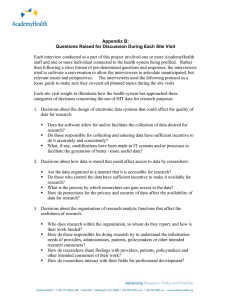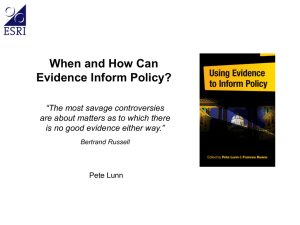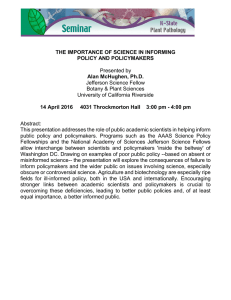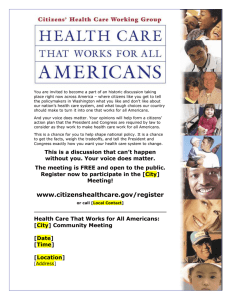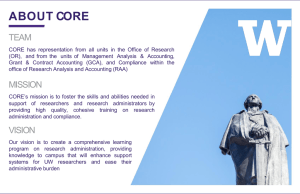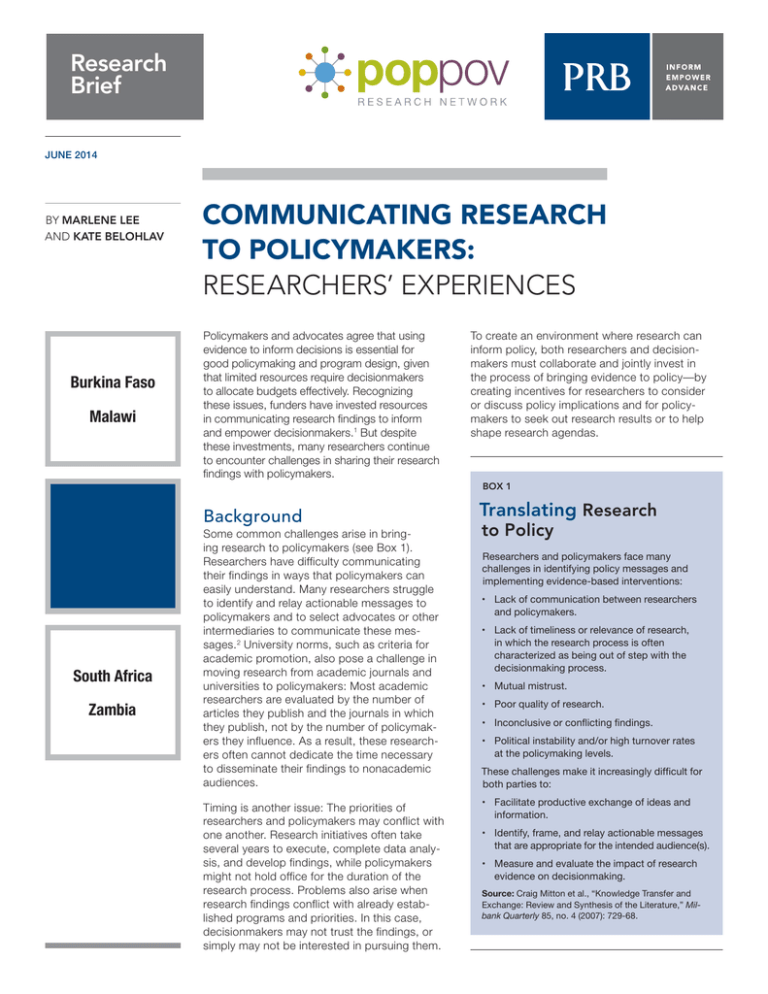
Research
Brief
JUNE 2014
BY MARLENE LEE
AND KATE BELOHLAV
Burkina Faso
Malawi
COMMUNICATING RESEARCH
TO POLICYMAKERS:
RESEARCHERS’ EXPERIENCES
Policymakers and advocates agree that using
evidence to inform decisions is essential for
good policymaking and program design, given
that limited resources require decisionmakers
to allocate budgets effectively. Recognizing
these issues, funders have invested resources
in communicating research findings to inform
and empower decisionmakers.1 But despite
these investments, many researchers continue
to encounter challenges in sharing their research
findings with policymakers.
To create an environment where research can
inform policy, both researchers and decisionmakers must collaborate and jointly invest in
the process of bringing evidence to policy—by
creating incentives for researchers to consider
or discuss policy implications and for policymakers to seek out research results or to help
shape research agendas.
BOX 1
Background
South Africa
Zambia
Some common challenges arise in bringing research to policymakers (see Box 1).
Researchers have difficulty communicating
their findings in ways that policymakers can
easily understand. Many researchers struggle
to identify and relay actionable messages to
policymakers and to select advocates or other
intermediaries to communicate these messages.2 University norms, such as criteria for
academic promotion, also pose a challenge in
moving research from academic journals and
universities to policymakers: Most academic
researchers are evaluated by the number of
articles they publish and the journals in which
they publish, not by the number of policymakers they influence. As a result, these researchers often cannot dedicate the time necessary
to disseminate their findings to nonacademic
audiences.
Timing is another issue: The priorities of
researchers and policymakers may conflict with
one another. Research initiatives often take
several years to execute, complete data analysis, and develop findings, while policymakers
might not hold office for the duration of the
research process. Problems also arise when
research findings conflict with already established programs and priorities. In this case,
decisionmakers may not trust the findings, or
simply may not be interested in pursuing them.
Translating Research
to Policy
Researchers and policymakers face many
challenges in identifying policy messages and
implementing evidence-based interventions:
• Lack of communication between researchers
and policymakers.
•
Lack of timeliness or relevance of research,
in which the research process is often
characterized as being out of step with the
decisionmaking process.
• Mutual mistrust.
• Poor quality of research.
• Inconclusive or conflicting findings.
• Political instability and/or high turnover rates
at the policymaking levels.
These challenges make it increasingly difficult for
both parties to:
• Facilitate productive exchange of ideas and
information.
• Identify, frame, and relay actionable messages
that are appropriate for the intended audience(s).
• Measure and evaluate the impact of research
evidence on decisionmaking.
Source: Craig Mitton et al., “Knowledge Transfer and
Exchange: Review and Synthesis of the Literature,” Milbank Quarterly 85, no. 4 (2007): 729-68.
BOX 2
Factors Facilitating
Communication of
Research Results
• Personal contact between researchers and policymakers.
• Timeliness and relevance of research.
• Inclusion of a summary with clear recommendations.
Source: Craig Mitton et al., “Knowledge Transfer and Exchange: Review
and Synthesis of the Literature,” Milbank Quarterly 85, no. 4 (2007):
729-68.
While practitioners have used a variety of approaches to
facilitate the exchange of information between researchers
and policymakers, studies have shown that a successful dissemination strategy has a range of communication
approaches, such as written research summaries and
policy briefs, electronic and web-based outreach tools,
and oral presentations (see Box 2).3 However, no universal
framework on successful research communication exists,
given that most accounts of such activities are based on
qualitative and context-specific anecdotes.
This brief highlights the experiences of four research
teams who communicated findings from studies supported under the William and Flora Hewlett Foundation’s
Population and Poverty Research Initiative (PopPov). Each
research endeavor was unique in its strategic approach,
subject matter, policy environment, and outcome. In
addition, different PopPov partners funded the grants for
each research study. The United Kingdom’s Economic
and Social Research Council (ESRC) funded a study of
emergency obstetric care in Burkina Faso; and a study
of unintended fertility in Karonga, Malawi. The Population Reference Bureau (PRB) awarded research grants for
a study of teenage pregnancy and education outcomes
in Cape Town, South Africa; and a study of household
family planning decisionmaking in Lusaka, Zambia. ESRC
required that research teams develop and implement a
communication plan, and report on its results, while PRB
made no specific research dissemination requirement.
Table 1 summarizes efforts of each research team to
inform policymakers of their research findings, while Table
2 presents the result of outreach to policy audiences—
the media, the public, and government authorities—and
policy outcomes. By highlighting the experiences, challenges, and successes of these research teams, this brief
may provide insights to researchers who seek to generate
policy-relevant evidence and to share actionable results
with policymakers.
TABLE 1
Policy Engagement Activities by Research Teams
CASE 1: TEENAGE
PREGNANCY IN SOUTH
AFRICA
Presentations and/or
information meetings with
ministers/local authorities
✔
CASE 2: OBSTETRIC
COMPLICATIONS IN
BURKINA FASO
✔
CASE 3: UNINTENDED
CHILDBEARING AND
FAMILY WELFARE IN
NORTHERN MALAWI
CASE 4: HOUSEHOLD
BARGAINING AND
EXCESS FERTILITY IN
ZAMBIA
✔
✔
Formal partnership with
ministries
✔
✔
Community engagement
Partnerships with advocacy
organizations
✔
Media coverage (local or
international)
✔
Policy briefs, newsletters,
other materials
2
www.prb.org
✔
✔
✔
✔
COMMUNICATING RESEARCH TO POLICYMAKERS
Case 1: Teenage Pregnancy in
South Africa
health and socioeconomic consequences of teenage pregnancy would inform the policy process.
RESEARCH PROGRAM
ENGAGEMENT ACTIVITIES
Researchers from the Southern Africa Labour and
Development Research Unit (SALDRU), University of
Cape Town, and their partners from the University of
Michigan, began a PopPov-supported research program
in 2008 to analyze links between teen fertility, educational attainment, and health outcomes in South Africa.
Their findings had the potential to inform policy and
program development in teen pregnancy prevention and
protective services for teen mothers and their children.
To bring their research to policymakers, the SALDRU
team, with financial assistance from the Hewlett Foundation, partnered with Baird’s Communications Management
Consultants (Baird’s CMC). Their goal was to increase trust
between policymakers and researchers. The team began
by conducting a stakeholder mapping exercise to identify
groups who would be interested in SALDRU’s ongoing
research, and selected the Department of Health, the
Department of Basic Education, the Department of Social
Development, and the National Welfare Forum. Baird’s
CMC reached out to these groups to create awareness of
the ongoing research, generate interest among policymakers, and demonstrate how the research could be useful
for formulating new policies.5 In addition to partnering with
Baird’s CMC, the SALDRU team also benefited from a messaging workshop facilitated by communications and advocacy experts with the Children’s Institute at the University of
Cape Town.
POLICY ENVIRONMENT AND CONTEXT
Overall, women in South Africa have been giving birth
to fewer children since the 1970s, though the rate of
teenage childbearing remains relatively high compared
to other countries.4 Teen childbearing has an adverse
impact on the education and health of teen mothers
and their children; the large number of young mothers in
South Africa is both a cause for social concern and an
impetus for policymakers to act. In 2008, some government departments indicated that they did not have the
statistics to adequately assess teen pregnancy nor the
legislation in place to address the issue. The Department
of Basic Education and the Department of Health, however, did have a mandate to draft regulations to address
teen pregnancy, and the latest research findings on the
The researchers met with the key stakeholders to share
preliminary research findings and to discuss how these
findings might be translated and used to support policy
discussion. The stakeholders largely responded positively to the outreach efforts, expressing interest in the
full research results and agreeing to a series of follow-up
presentations.
TABLE 2
Policy Results From Issues Addressed by Research Teams
CASE 1: TEENAGE
PREGNANCY IN SOUTH
AFRICA
Policy change/contribution to
high-level policy document
CASE 2: OBSTETRIC
COMPLICATIONS IN
BURKINA FASO
✔
CASE 3: UNINTENDED
CHILDBEARING AND
FAMILY WELFARE IN
NORTHERN MALAWI
CASE 4: HOUSEHOLD
BARGAINING AND
EXCESS FERTILITY IN
ZAMBIA
✔
Follow-on research requested
and formalized
✔
Contribution to debate on
issue
✔
Additional materials
requested
✔
COMMUNICATING RESEARCH TO POLICYMAKERS
✔
✔
✔
www.prb.org
3
The SALDRU researchers presented key findings in meetings, focusing on summarizing the results in a simple and
nontechnical manner. They avoided presenting specific
policy insights or advice, instead talking through and teasing out the possible policy implications of the research with
policymakers. At the end of each presentation, stakeholders were given an opportunity to respond to the research
findings. Stakeholders also provided formal feedback via a
brief survey.
In general, stakeholders provided positive comments and
expressed interest in follow-on activities. Specifically, the
Department of Social Development requested that an
additional presentation be made to a larger audience of
policymakers and representatives from both the national
department and South African provinces. Members from
the Department of Health praised the presentation and
asked that the team gather comparative research on
teenage pregnancy from other countries in order to more
precisely define the context of the study findings. They
also recommended that researchers prepare a paper
to examine the policy implications and relevance of the
research findings.
SALDRU was also invited to join a national partnership on
teen pregnancy. They participated in two meetings in 2013.
As part of the ongoing communications initiative, SALDRU
staff prepared a series of working papers and presentations
examining the consequences of teenage childbearing and
a policy brief that summarized key research results and
offered discussion points and messages for policymakers.
PRB also prepared a research brief that synthesized the
findings from several key SALDRU studies. In response to a
request from the South African Broadcasting Corporation,
PRB staff participated in a radio interview.
POST-ENGAGEMENT, CHALLENGES,
AND OUTCOMES
Outreach and policy discussions heavily depend on joint
participation. The outreach exercise resulted in opportunities for future engagement and collaboration, but other
commitments made scheduling difficult. For example, even
with scheduled presentation times, an emergency occurring
just as researchers arrived for the presentation prevented
policy and program staff from participating. The lead
researchers, however, did have the opportunity to engage
policymakers in the development of the research agenda
for another project. Although the outcome of the next
research effort and engagement is not yet available, the
initial work looks promising for engaging policymakers. The
willingness of funders to support a stakeholder workshop
in the proposal development stage of a follow-on project
made it possible to engage policymakers even before the
research agenda was finalized for this future project.
4
www.prb.org
Case 2: Obstetric Complications in
Burkina Faso
RESEARCH PROGRAM
For many women, emergency obstetric care is a catastrophic expenditure that may potentially contribute to a
cycle of poverty and poor health. Few studies have investigated the effect of these expenditures on families, particularly in the long term. To address this lack of information,
Veronique Filippi from the London School of Hygiene and
Tropical Medicine; Katerini Storeng from the University of
Oslo; Rasmané Ganaba, Maurice Yaogo, and Nicolas Meda
from AfricSanté; and their colleagues conducted a series
of studies to assess the links between the consequences
of such events and the health and well-being of the women
and their families.
Several funders have supported this research program,
and all grant support emphasized either communicating
the research or creating a community of practice. These
grants and communication emphases have helped
elevate the research results among policymakers. They
also increased the researchers’ ability to influence the
policy process.
POLICY ENVIRONMENT AND CONTEXT
Although the number of maternal deaths has decreased
substantially over the past 20 years, many women in
Burkina Faso still experience near-fatal complications during pregnancy or childbirth. At the time of the study, the
cost of treating these complications often represented an
expense that could push a family into economic insecurity.
To reduce financial barriers to maternal health care services, Burkina Faso adopted a policy in 2006 to subsidize
deliveries and emergency obstetric care. The subsidy
covered 80 percent of the total cost of treatment and fully
exempted the poorest women from paying for obstetric
care, but implementation was difficult.6 The uncovered
costs represented a substantial proportion of some women’s income—as much as seven days of income earned.7
And in many cases, health care workers were often unsure
which women were fully exempt.
ENGAGEMENT ACTIVITIES
The research team integrated a variety of engagement
activities to circulate their research findings, including a
partnership with a local nongovernmental organization
(NGO), meetings with policymakers, engagement with the
media, and production of policy briefs. Amnesty International (AI) asked to partner with the research team as part
of AI’s ongoing campaign for reducing maternal mortality in
Burkina Faso. The researchers provided AI with technical
assistance and information on the study findings. AI used
COMMUNICATING RESEARCH TO POLICYMAKERS
these findings for advocacy efforts. The partnership also
enabled the research team to reach high-level politicians.
Researchers used several sources of funding to maximize
the impact of dissemination, including grants that specifically
targeted research communication. In addition to collaborating with an advocacy organization and meeting with policymakers, the researchers engaged civil society organizations
and the media to disseminate their findings. AfricSanté, the
in-country partner research institution, received an award
for innovative journalism on the topic; and Burkina Faso’s
national radio station broadcasted AfricSanté’s materials.
Radio France International interviewed the researchers, who
highlighted issues of catastrophic costs and emergency
obstetric care. The researchers also initiated and contributed
to two research briefs, distributed these briefs to the UK
Department for International Development’s (DFID) advisers,
UN agency staff, and NGOs working on reproductive health
and international development.
OUTCOMES
In 2010, the president of Burkina Faso announced that all
charges for emergency obstetric care would be lifted (not
just partially subsidized), reducing the financial burden for
many women and their families who had not been fully
covered under the previous policy. The evidence generated
and produced through this research project ultimately contributed to this modification, which Amnesty International
had requested during a meeting with the president.
More generally, the research has contributed to an emerging policy debate in Burkina Faso and the West African
region about the need to provide financial protection in
order to increase access to care and reduce catastrophic
expenditures. The researchers have noted that the longterm support provided through multiple funders has
enabled them to both build and develop long-term relationships that have contributed to the policy impact of their
research.
surements (height and weight) to ongoing surveys at the
Demographic Surveillance Site (DSS) in the Karonga district.
Their analyses looked at the effects of unintended pregnancies on children’s physical development and on educational
outcomes for siblings.
POLICY ENVIRONMENT AND CONTEXT
In Malawi, one in four women does not wish to become pregnant, but is not doing anything to prevent it.8 This high rate
of unmet need for contraception contributes to high levels of
fertility, and in a low-income country like Malawi, caring for
additional children often has negative effects on household
income and well-being. Each additional child means another
individual who needs access to already limited income and
resources, thus leading to higher levels of poverty. Additional
children may also result in poorer health and educational outcomes for both women and their children through pathways
such as nutritional deprivation, stunted growth and development, and fewer years of completed schooling.
KPS staff have a history of providing support for clinical services in the Karonga district as well as areas to the south. KPS
activities also support Malawi’s national programs by providing data and assisting ministries. For example, KPS staff have
drafted a Ministry of Health application to GAVI Alliance (formerly Global Alliance for Vaccines and Immunisation) for support of a vaccination program. KPS staff also serve on national
committees and teach in Malawi’s higher-education institutions.
The KPS work program in the 2009 to 2011 period included
support from the Wellcome Trust to extend public engagement activities. These funds provided an opportunity to study
attitudes and beliefs of the local community, including beliefs
about research. As part of their goals, KPS staff sought to
communicate results in a more culturally appropriate manner.
ENGAGEMENT ACTIVITIES
RESEARCH PROGRAM
Under the KPS program of work, staff at the study site implemented the Karonga Engagement Program (KEP), to increase
community members’ understanding of the KPS work and to
contribute to the improvement of community health through
strengthened partnerships at community, district, and national
levels. A member of the Baschieri research team, Albert Dube,
led community engagement from 2010 to 2011. The program
included information-sharing days with different education
stakeholders in order to increase awareness of the research.
In 2008, Angela Baschieri and colleagues at the London
School of Hygiene and Tropical Medicine conducted a
series of studies as part of the Karonga Prevention Study
(KPS), now called the Malawi Epidemiology and Intervention Research Unit (MEIRU). Their research assessed how
unwanted births and fertility intentions affect physical growth
of children and school retention. The research team added
questions on fertility intentions and children’s physical mea-
At the national level, researchers met with key stakeholders
from institutions such as the Malawi Ministry of Health, the
College of Medicine, the National AIDS Commission, and
the TB Control Program. At the community level, the team
participated in a series of monthly development meetings
and information seminars, and also organized an ongoing community-level engagement program. These activities
aimed to increase stakeholder awareness and understanding
Case 3: Unintended Childbearing
and Family Welfare in Northern
Malawi
COMMUNICATING RESEARCH TO POLICYMAKERS
www.prb.org
5
of the KPS activities and to contribute to the improvement
of community health. Table 3 outlines the specific activities
that research staff engaged in at each level, and the figure on
page 7 provides an example of a KPS newsletter.
In May 2012, the Baschieri team presented research results at
the National Leaders Conference on Family Planning, Population, and Development, held in Lilongwe. The team also
participated in the high-level panel at this meeting. Malawi’s
National Population Policy was an outcome of this meeting.
OUTCOMES
Overall, the fertility intentions project has contributed to
high-level discussion about the role of family planning in
fostering economic development in Malawi. Public response
to community engagement initiatives continues to be posi-
Case 4: Household Bargaining and
Excess Fertility in Zambia
TABLE 3
Policy and Community Engagement Activities, Malawi
Karonga Prevention Study
NATIONAL-LEVEL
ACTIVITIES
• Express support
toward national
family health
research
priorities.
• Inform
stakeholders of
the latest KPS
progress and
research findings.
• Collaborate with
national agencies
and academic
institutions to
develop and
implement
research grants.
• Conduct
dissemination
workshops and
best-practices
trainings for
high-level
policymakers.
DISTRICT-LEVEL
ACTIVITIES
• Offer technical
support to
initiatives intended
to improve health
screening and
diagnosis capacity
in health centers.
• Conduct monthly
professional
development
trainings and
workshops for
local health
personnel and
service providers.
COMMUNITY-LEVEL
ACTIVITIES
• Publish and
distribute
quarterly
KPS project
newsletters
throughout
the Karonga
community.
• Develop
awareness about
key issues in
child nutrition,
health, and wellbeing through
community
mobilization and
campaigns during
local cultural
events (traditional
dancing recitals,
youth drama
performances).
• Information-Sharing Days. Project team members gather
stakeholders from the community, district-level management
offices, and education ministries’ advisory boards to discuss
ongoing projects and research findings. The goals are to raise
awareness of the project; and to facilitate interaction between
policymakers, researchers, and the public. As of January 2012,
over 260 key informants and community-based organizational
leaders have participated.
6
www.prb.org
tive, and stakeholder participation in information campaigns
and sharing days remains strong. Community awareness of
outreach activities in the larger KPS program of work has
increased—mainly because engagement activities have contributed to greater public understanding of the research findings and key health messages. The KPS project staff intends
to gather enough feedback and response data to be able to
quantitatively assess the impact of the engagement program
on public awareness. The Baschieri team’s dissemination of
research results from the ESRC/Hewlett-funded project benefited from being embedded in a long-standing research site
with a strong commitment to community engagement. The
dissemination efforts also benefited from taking place when
the Wellcome Trust’s funding facilitated KPS improvements in
communication with the public.
RESEARCH PROGRAM
Understanding the factors that drive high levels of unmet
need could give policymakers and interest groups information to make decisions about the provision of family planning, health, and education programs in Zambia. In 2007,
Nava Ashraf and colleagues at Harvard University conducted
an experiment to investigate one factor influencing the
demand for contraception: the impact of the husband’s participation in decisions about contraceptive use.
POLICY ENVIRONMENT AND CONTEXT
In Lusaka, Zambia, family planning services are readily available, yet unmet need for contraception remains high, with
one in four women reporting a desire to prevent childbearing, but not doing anything to prevent it.9 Contraceptives
and family planning services promote a wide range of health
and socioeconomic benefits. Allowing women to time their
births, increases women’s investments in education and
participation in the labor market at childbearing ages. High
levels of unmet need, therefore, are a cause for both social
and economic concern in Zambia.
ENGAGEMENT ACTIVITIES AND OUTCOMES
The Zambian government is committed to evidence-based
policymaking, and is receptive to developing research partnerships and using findings. Ashraf and colleagues began
working collaboratively with the Zambian government in
2006 and developed formal partnerships with both the Ministry of Health and the Ministry of Education.10 The researchers found that providing women access to contraceptives
in private increased contraceptive use and reduced fertility.
However, they also learned that this private access could be
detrimental to a couple’s sense of well-being.
COMMUNICATING RESEARCH TO POLICYMAKERS
FIGURE 1
Front Page of a Karonga Prevention Study Newsletter
Source: Albert Dube et al., “Unintended Childbearing and Family Welfare in Northern Malawi,” presentation delivered at the Sixth Annual Research Conference on Population, Reproductive
Health, and Economic Development, Accra, Ghana, 2012.
The strong partnership between the research team and the
Ministry of Health allowed for trust and movement toward
a shared goal. The Ministry of Health requested follow-on
research as a result of the study team’s presentation of findings to assess both the effectiveness of maternal mortality
education on the use of family planning and fertility outcomes, and how education influences male acceptance of
family planning.11
The research team’s partnership with the government of
Zambia also extends to dissemination. The ministry has
facilitated the team’s access to in-country working groups
on reproductive health and maternal mortality. When the
COMMUNICATING RESEARCH TO POLICYMAKERS
research team presented results to the Ministry of Health,
other members of these working groups were present,
including the Society for Family Health, USAID, and UNFPA.
Other networks have also been instrumental in disseminating the team’s research results to policymakers. Both Ashraf
and co-author Field are affiliates of the Jameel Poverty
Action Lab (J-PAL). The J-PAL policy group focuses solely
on creating policy briefs from academic papers and making
them available to practitioners. A J-PAL newsletter circulated
to many academics and practitioners highlighted results of
the study in Lusaka.
www.prb.org
7
Potential for Collaboration and
Consensus
In addition to funding research, PopPov has included a
focus on bringing researchers and policymakers together
and encouraged researchers to develop effective strategies
for communicating study findings. Dissemination efforts by
researchers funded through PopPov reflect a diversity of
policy engagement strategies and promising results: Policy
debates have ensued, policymakers are requesting additional
research, and policies have shifted.
Addressing time constraints and other obstacles in the
communications between researchers and policymakers is
critical. The cases presented here provide some guidance.
Engaging professional services such as a communications
firm to assist in approaching high-level officials and crafting appropriate messages can relieve researchers of some
tasks. However, unless these professionals can understand
the research findings and are adept at translating them for a
nontechnical audience, researchers still have to spend a lot of
time simplifying the results for a nontechnical audience. Collaboration with communication intermediaries, who specialize
in fields similar to the research topics, such as AfricSanté and
PRB, can facilitate communication of specific findings and
relieve the researcher of some of the translation tasks. Also,
making researchers aware of culturally appropriate messaging can help engage the public and public officials. Although
the initial investment in research translation can be costly, the
skills that researchers develop—the ability to make nontechnical presentations and to write for policy audiences—have the
potential to alleviate time burdens as researchers become
more familiar with communication tools and strategies.
The Zambia case, in contrast with the South Africa case,
highlights the importance of early engagement of stakeholders in the research endeavor. Involving government authorities
in the development of the research questions paves the way
for having them listen to the results. The engagement of one
8
www.prb.org
important stakeholder also opens doors to communication
with other stakeholders positioned to use the research results
in their funding and programming decisions.
Evidence-based policymaking requires that researchers
and policymakers collaborate and communicate effectively
with each other. How to bridge the cultural and professional
divides between these two communities is not always clear,
and effective strategies are not often easy to implement.
Moreover, preparing research findings for policy audiences
has proven to be a time-consuming task that requires particular skills, financial support for sustained outreach efforts, and
participation of a wide array of stakeholders. The cases presented in this brief demonstrate that some degree of success
in communicating results and having impact is achievable
with a high level of commitment on the part of researchers,
funders, and stakeholders.
Acknowledgments
This brief was prepared by Kate Belohlav, research associate in International Programs, and Marlene Lee, program
director, Academic Research and Relations, at PRB, with
initial contributions from Mahesh Karra. This publication is
made possible by the generous support of the William and
Flora Hewlett Foundation, as part of the foundation’s Population and Poverty Research Initiative (PopPov). The authors
wish to thank Jeremy Shiffman for his comments.
The authors wish to thank Murray Leibbrandt of the University of Capetown; Angela Baschieri of the University of
Southampton; Veronique Filippi of the London School of
Hygiene and Tropical Medicine; Katerini Storeng of University of Oslo; Muarice Yaogo and Rasmané Ganaba of
AfricSanté; and Nava Ashraf of the Harvard Business School
for their review of this brief.
© 2014 Population Reference Bureau. All rights reserved.
COMMUNICATING RESEARCH TO POLICYMAKERS
References
1 John N. Lavis et al., “How Can Research Organizations More Effectively Transfer
Research Knowledge to Decision Makers?” Milbank Quarterly 81, no. 2 (2003):
221-48.
2 Lavis et al., “How Can Research Organizations More Effectively Transfer Research
Knowledge to Decision Makers?”
3 Craig Mitton et al., “Knowledge Transfer and Exchange: Review and Synthesis of
the Literature,” Milbank Quarterly 85, no. 4 (2007): 729-68.
4 Mahesh Karra and Marlene Lee, Human Capital Consequences of Teenage
Childbearing in South Africa (Washington, DC: Population Reference Bureau,
2012).
5 Baird’s Communications Management Consultants Ltd., “Engagement With
Policymakers: Human Capital Consequences of Teenage Pregnancy,” Executive
Progress Report (Newport, UK: Baird’s CMC, 2008).
7 Mia Foreman and Marlene Lee, Beyond Maternal Mortality: Surviving an
Obstetric Complication in Burkina Faso (Washington, DC: Population Reference
Bureau, 2012).
8 Malawi National Statistical Office (NSO) and ICF Macro, Malawi Demographic
and Health Survey 2010 (Calverton, MD: NSO and ICF Macro, 2011).
9 Zambia Central Statistical Office (CSO); Zambia Ministry of Health; Tropical
Diseases Research Centre, University of Zambia; and Macro International Inc.,
Zambia Demographic and Health Survey 2007 (Calverton, MD: CSO and Macro
International Inc., 2009).
10Nava Ashraf, A Woman’s World (Cambridge, MA: Harvard Business School,
2012), accessed at www.hbs.edu/faculty/Profile%20Files/WomensWorld_
OnePage_nava_9-18-12_24e227c8-e57d-4f92-9e27-6fbcf1a3e60f.pdf, on May
9, 2014.
6 Valery Ridde et al., “The National Subsidy for Deliveries and Emergency Obstetric
Care in Burkina Faso,” Health Policy and Planning 26, no. 2 (2011): ii30-40.
11Nava Ashraf et al., Maternal Mortality Risk and Male Involvement (Cambridge,
MA: Harvard Business School, 2012), accessed at www.hbs.edu/faculty/
Profile%20Files/MFP_OnePage_9-18-12_de3a8b56-2f3c-40b4-99875031e981b723.pdf, on May 9, 2014.
Additional Resources
Véronique Filippi et al., “Health of Women After Severe Obstetric Complications in
Burkina Faso: A Longitudinal Study,” The Lancet 370, no. 9595 (2007): 1329-37.
Cally Ardington, Nicola Branson, and Murray Leibbrandt, “Health Outcomes for
Children Born to Teen Mothers in Cape Town, South Africa,” Southern Africa Labour
and Development Research Unit Working Paper 55 (2011).
Cally Ardington, Alicia Menendez, and Tinofa Mutevedzi, “Early Childbearing, Human
Capital Attainment and Mortality Risk,” Southern Africa Labour and Development
Research Unit Working Paper 56 (2011).
Cally Ardington, Nicola Branson, and Murray Leibbrandt, “Trends in Teenage
Childbearing and Schooling Outcomes for Children Born to Teens in South Africa,”
Southern Africa Labour and Development Research Unit Working Paper 75 (2012).
Nava Ashraf, Erica Field, and Jean Lee, “Household Bargaining and Excess Fertility:
An Experimental Study in Zambia,” 2nd revision submitted, American Economic
Review (September 2013).
Angela Baschieri, “Unintended Childbearing and Family Welfare in Rural Malawi,”
impact report to ESRC, grant number RES-183-25-0013, September 2012.
Karonga Prevention Study, accessed at www.lshtm.ac.uk/eph/ide/research/kps/.
Vimal Ranchhod et al., “Estimating the Effect of Adolescent Fertility on Educational
Attainment in Cape Town Using a Propensity Score Weighted Regression,” Southern
Africa Labour and Development Research Unit Working Paper 59 (2011).
Katerini Tagmatarchi Storeng et al., “Paying the Price: The Cost and Consequences
of Emergency Obstetric Care in Burkina Faso,” Social Science & Medicine 66, no. 3
(2008): 545-57.
Katerini Tagmatarchi Storeng et al., “Beyond Body Counts: A Qualitative Study of
Lives and Loss in Burkina Faso After ‘Near-Miss’ Obstetric Complications,” Social
Science & Medicine 71, no. 10 (2010): 1749-56.
Katerini Tagmatarchi Storeng et al., “Mortality After Near-Miss Obstetric
Complications in Burkina Faso: Medical, Social, and Health-Care Factors,” Bulletin
of the World Health Organization 90, no. 6 (2012): 401-76.
Nicola Branson, “Health and Education Outcomes for Children Born to Teen Mothers
in South Africa,” unpublished dissertation, University of Cape Town, 2011.
POPULATION REFERENCE BUREAU
The Population Reference Bureau INFORMS people around the world about
population, health, and the environment, and EMPOWERS them to use that
information to ADVANCE the well-being of current and future generations.
www.prb.org
POPULATION REFERENCE BUREAU
1875 Connecticut Ave., NW
Suite 520
Washington, DC 20009 USA
202 483 1100 PHONE
202 328 3937 FAX
popref@prb.org E-MAIL

